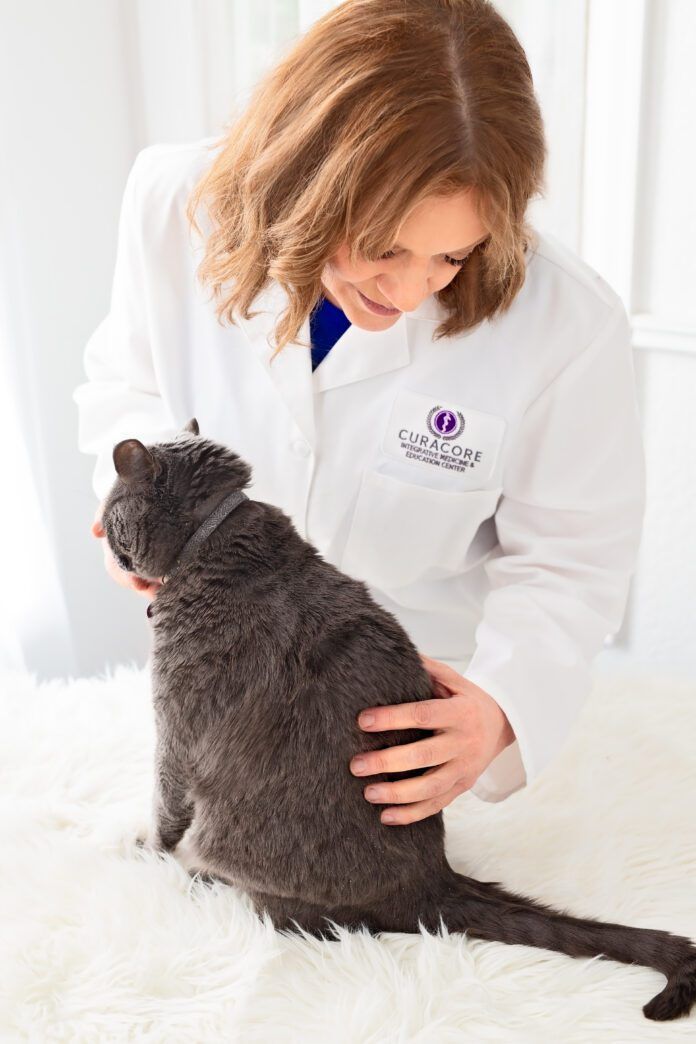Dr. Narda Robinson, a Colorado-based physician, points out that some doctors who treat elderly people now offer a type of medical care called integrative geriatrics. It means they rely on drugs and procedures such as operations when they need to but, as much as possible, make use of non-pharmacologic, low-cost, high-touch methods to treat their patients. Think: acupuncture, massage, physical therapy, and the like.
The National Institutes of Health would appear to sanction this approach. It defines integrative health as medical care that brings together conventional and complementary care in a coordinated effort.
Why are we bringing this up in Catnip? Dr. Robinson is a veterinarian as well as a physician and says that “many aspects of integrative human geriatrics also apply to cats.” In a publication called Veterinary Practice News, she argues that an integrative approach that avails itself not just of pills and invasive procedures but also the widest possible variety of tools to treat chronic pain, mobility problems, and lingering diseases in older cats gives people the widest flexibility possible in trying different therapies and seeing what works best.
“As cats’ needs evolve over time, so can the interventions selected,” Dr. Robinson writes. “For example, cats with arthritis or pain from other causes could begin with several sessions of medical acupuncture, massage, and laser therapy, accompanied by consultations about home care and additional ways to keep cats comfortable between visits.” If the situation changes, the approach can be revisited. It’s not just a matter of prescribing stronger doses of medications, which may come with various side effects.
Approaches should be vali-dated by western standards
“Primitive, folkloric descriptions” of how integrative medicine works do not cut it, Dr. Robinson says. “We do not describe how drugs and surgery work by relying on myths and metaphors” but with science, and the same rigor should be applied to the mechanisms of other types of medical treatments. For example, it has now been demonstrated that acupuncture alleviates pain and restores quality of life not by moving invisible energy but by acting on the central nervous system and connective tissues. That’s why, Dr. Robinson says, cats with arthritis and back pain often benefit by acupuncture’s ability to reduce central and peripheral nervous system sensitization and relax tension in the back and neck.
Both the American Animal Hospital Association and the American Association of Feline Practitioners agree. They say in jointly issued guidelines that “there is a solid and still growing body of evidence for the use of acupuncture for the treatment of pain in veterinary medicine to the extent that it is now an accepted treatment modality for painful animals.”
It’s the same for other modalities that once were relegated to the so-called kooky fringes. Thus, if you decide to take your senior cat (or a cat of any age) to a veterinarian who will treat a condition with an integrative approach, you have a right to expect that your pet’s doctor can explain to you how the treatment she proposes is supposed to work — and how strong the evidence is that it will.
Here’s a look at a couple of other modalities used by vets who practice integrative geriatrics.
Laser Therapy. The proof for laser therapy probably isn’t as robust as for acupuncture. Gold-standard evidence is lacking. But preliminary evidence in lab animal models suggests it may expedite wound repair. It’s thought that laser therapy induces a photochemical reaction in cells, increasing production of substances at the molecular level that bring more oxygen to tissues to reduce inflammation. It’s also believed to enhance cell proliferation. Veterinarians who use the modality have seen improvements in inflamed tendons and spasmodic muscles that weren’t helped with more traditional therapies.
That said, a veterinarian has to know what she’s doing. Dr. Robinson notes that a cat can experience overheating if the therapy is applied too intensely with high-power laser units. She recommends not using the highest-power units — Class IV — on a cat’s head because of unknown risks to the feline eye and brain.
Massage. Admittedly, no research exists yet for massage in cats. But in geriatric people, massage has been shown to improve musculoskeletal function, depression, and gastrointestinal motility. Part of the benefit may have to do with what is known as the gate theory. Only so many neurological signals can make it through the “gate” of sensation at once, so the sensations of pleasure and pressure crowd out sensations of pain.
If you want to try massage on your cat to allow him to settle down more restfully, choose a veterinary massage therapist who has had at least 200 hours of training. That’s the requirement of the National Board of Certification for Animal Acupressure and Massage (nbcaam.org). Furthermore, all the training should be hands-on, not just watching videos of people conducting animal massage.
Keep in mind that there are a number of other integrative approaches to treating illness and pain in your cat. If a vet recommends that your pet lose weight with a modified meal plan in order to relieve stress on his joints and tendons (see article below), that’s integrative medicine because it gets at the problem other than with (or in conjunction with) analgesics.
A plan to engage your cat in more (or less, or different) physical activity to help him work through a problem is also a component of integrative medicine. The concept might sound like something you have never considered for your cat, but you may have been applying it nonetheless.




